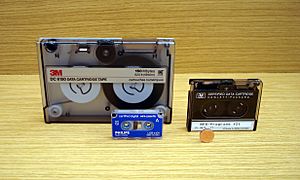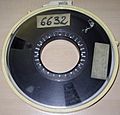Magnetic tape data storage facts for kids
Magnetic Tape Storage is a way to save digital information on a long, thin strip of special tape. Think of it like a super-long cassette tape, but for computer data! Even though newer ways to store data exist, magnetic tape is still very important, especially for making backup copies of large amounts of information.
Contents
What is Magnetic Tape Storage?
Magnetic tape storage uses a long ribbon coated with magnetic material. This material can be magnetized in tiny spots. Each spot can represent a "1" or "0". These are the basic building blocks of computer information. A special machine called a tape drive reads and writes these magnetic patterns onto the tape. It's a bit like how old VCRs recorded movies on tape, but for computer files instead of videos.
How Does Magnetic Tape Work?
A tape drive has a read/write head that moves across the tape. When writing data, the head creates tiny magnetic spots on the tape. When reading data, it detects these magnetic spots. The tape moves very fast past this head. This allows for quick saving or loading of information. Data is usually stored in a sequence, one bit after another. This means you often have to wind the tape to find specific information.
Why Do We Still Use Magnetic Tape?
Even with modern hard drives and cloud storage, magnetic tape is still widely used today. It's especially popular for backing up huge amounts of data. Here are a few reasons why:
- Cost-Effective: Tape is generally cheaper per gigabyte than hard drives. This makes it great for storing massive archives.
- High Capacity: A single tape cartridge can hold an incredible amount of data. Some can store many terabytes of information.
- Long Lifespan: Tapes can last for decades if stored properly. This makes them reliable for long-term data archiving.
- Security: Once data is written to tape and the tape is removed from the drive, it's "offline." This means it's safe from cyberattacks or viruses.
A Look Back: History of Tape Storage
The idea of magnetic recording goes back to the late 1800s. However, magnetic tape for computers really started in the 1950s.
Early Days: 1950s and Beyond
In 1951, the first commercial computer, the UNIVAC I, used magnetic tape. It was a huge step forward for storing data. These early tapes were large reels, often 10.5 inches across. They were used to store programs and data for big mainframe computers.
Evolution of Tape Formats
Over the years, tape storage evolved a lot.
- Reel-to-Reel Tapes: These were the earliest forms, like the IBM 729V. They were open reels of tape that needed to be threaded onto a drive.
- Cartridges and Cassettes: Later, tape moved into enclosed cartridges. This made them easier to handle and protect. Examples include quarter-inch cartridges (QIC) and digital data storage (DDS) tapes. These were more compact and user-friendly.
- Modern Formats: Today, formats like Linear Tape-Open (LTO) are common. They offer very high capacities and fast data transfer speeds. They are often used in data centers for large-scale backups.
How Data is Stored on Tape
There are different ways data is written onto the tape:
- Linear Recording: In this method, data is written in parallel tracks along the length of the tape. The read/write head moves back and forth to access different tracks.
- Linear Serpentine Recording: This is similar to linear, but the tape reverses direction at the end of a track. It then writes the next track in the opposite direction. This allows more data to be packed onto the tape.
- Helical Scan Recording: This method is like how VCRs record video. The tape wraps around a spinning drum with read/write heads. The heads write data in diagonal stripes across the tape. This allows for very high data density.
Even though magnetic tape might seem old-fashioned, it remains a vital part of how big companies and organizations protect their valuable digital information.
Images for kids
-
An IBM 3590 data cartridge can hold up to 10GiB uncompressed.
See also
 In Spanish: Cinta magnética de almacenamiento de datos para niños
In Spanish: Cinta magnética de almacenamiento de datos para niños









